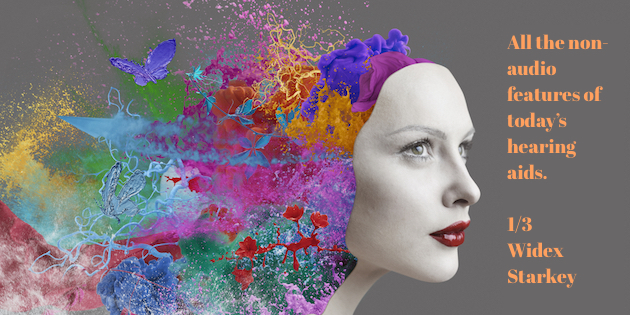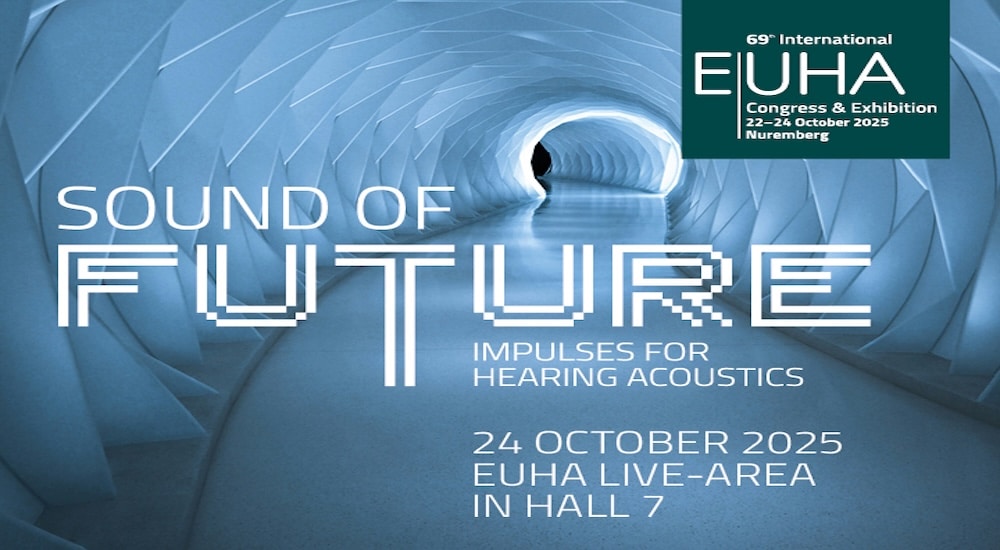Just...extra smart: modern hearing aids stripped of their audio elements
technology
What are we left with when we take away all the strictly hearing-related elements from the latest hearing devices in the marketplace?

We have yet to see the device that will drone-trim your hair while you listen to streamed electronica, or perhaps interpret the echoes of your gastroenteric chambers to send out a pizza order for the best-matched topping to your health requirements. But joking aside, from some companies there is a lot of marketing emphasis on the extra benefits of today’s hearing aids, things that go way beyond superbly enhanced amplification. They include benefits and trimmings!
Some manufacturers, however, are so far sticking to hearing aids for hearing, and holding off on adding more technological extras than Blueooth streaming. Our UK magazine, Audio Infos, asked producers for the lists of just the smart extras, such as fall detection, fitness tracking, and fast-developing ideas from today’s mother of all invention: artificial intelligence.
STARKEY
We can strip all the hearing stuff from a Starkey Livio aid and have quite a party. And if we’re not fit enough to know when the party’s over, the extras will ensure someone will come and pick us up from the floor.
The Livio hearing aids recently heading the portfolio of US-based Starkey Hearing Technologies have been marketed with plenty of emphasis on the extra features packed into their tiny casings, and their controlling App Thrive. But while these eye-catching extras have helped win Livio prestigious global tech and design awards, you will not find Starkey about to soften its focus on hearing. Audio Infos asked Chief Innovation Officer Dave Fabry to explain his company’s widening of scope.
Audio Infos: In the hearing aid market as a whole, can we say that the straight hearing-and-sound-only hearing aid, excepting cheap OTC amplification devices or marketing novelties, is about as defunct as a phone-only mobile?
Dave Fabry: While I agree that hearing aids have transitioned from “single purpose” devices into multipurpose, multifunction ones, the reality is that many hearing aid users—particularly those who are first-time users who experience situational difficulties—simply want to hear better in quiet and noisy listening environments. That should remain the “why” of every incumbent hearing aid manufacturer: to connect people back to their lives by providing exemplary speech understanding and sound quality in “real world” listening environments. We have seen a rapid conversion from replaceable to rechargeable batteries, and I believe that we will also see improvements in output transducers to improve performance for this important function. I believe that smart-phone connectivity is “table stakes” for high-end devices, but I believe that there is an opportunity for differentiation, rather than commoditisation, in “basic”, affordable, high-quality devices.
AI: Starkey Hearing Technologies has embraced healthable and extra features in hearing aids with more gusto than other manufacturers, and these features seem streamlined to the AI tech at the heart of new Starkey aids. What were the main reasons behind Starkey’s investment in such multi-faceted hearing technology?

DF: Starkey has a long history with developing patient-focused innovations in the hearing aid industry. We led the way with small, custom devices that provided comfort, convenience, and cosmetic benefits, and we currently offer the industry’s only custom rechargeable 2.4 GHz instrument. Unfortunately, there remains a stigma associated with hearing loss and hearing aids, and the adoption rate in the UK (and the US) of hearing aids by those with hearing loss remains well below 50%. Generationally, we are starting to see that many younger patients are less focused on the cosmetic aspect of hearing aids, given the array of attractive options for custom and over-the-ear styles, and are increasingly interested in connectivity to smart phones. In addition, we have committed to using embedded sensors, machine learning and artificial intelligence (AI) to provide hearing aid users with the ability to monitor physical activity and social engagement while wearing their hearing aids. Hearing loss has high comorbidity with other important health conditions, including cardiovascular function, depression, isolation, loneliness, and cognitive decline. Our motto is “hear better, live better”, and by using sensors and AI to measure and display physical activity and social engagement, we have been raising importance for the role of hearing in overall health and wellness. In addition, we have also used embedded sensors and algorithms that are capable of fall detection, which is more common in individuals with hearing loss, and sending a text notification with physical location to up to three trusted contacts. We have received very favourable response from the market, including patients, family members, and caregivers regarding the “peace of mind” that this provides to family members regarding their loved ones. Finally, we have also introduced a “Companion app” that provides a mechanism for trusted contacts – with permission of the hearing aid user – to monitor physical activity, social engagement, and fall detection in real time. In turn, this enables family members to encourage and motivate their loved ones to be more active and engaged with the world around them.
AI: With such command of technology in these different directions, does Starkey have any plans to work on personal devices that contain only non-hearing, non-sound features? Or will your focus always incorporate hearing?
DF: Starkey’s mission is to build caring products that connect people through better hearing. Our vision is to lead the world in hearing health and wellness for patient-drive care. With nearly half a billion people worldwide with what the World Health Organisation (WHO) considers to be “disabling” hearing loss, and only 17 million hearing aids sold worldwide last year, our priority will be to increase adoption rate by those with hearing loss worldwide.
It won’t be long before there is even more in a Starkey hearing aid, but to date this is the list of its extra-hearing stuff:
- Thrive Care app
- OrCam® Vision Aid
- Fall Alert – an alternative alert system to neck- or wrist-worn devices.
- Translate – available since 2018, translates 27 languages in real time.
- Transcribe
- Thrive Assistant-Direct help for using the Thrive app
- Find My Phone – a recently added feature
- Reminders
- Brain Tracking
- Body Tracking
- Auto On/Off
- Tap Control
- Voice Commands for controlling hearing aids
- Alexa Facility with information direct to hearing aids
- Siri through your hearing aids
- Find my hearing aids
- Custom programme with geotag location for auto activation
- Fine tuning of programmes by user
- Self Check hearing aid diagnostic tool
- Mask Mode
- Car Mode
WIDEX
(Non audio features vary depending on technology level)
Although the launch of WIDEX MOMENT towards the end of 2020 brought greater incorporation of AI in WS Audiology’s Widex brand devices, a ˝pure and natural˝ sound remains very much the goal of the range of different features in the group’s hearing aids. But Widex is now talking more about the smart extras.
- Artificial Intelligence – An AI use oriented towards the SoundSense Learn feature for personal user programmes. The AI-gathered data through Real-Life Insights feeds back to the professional, but again this is hearing-centred.
- Direct 2.4 GHz Bluetooth Streaming – what is expected to be the standard Bluetooth for all hearing aids by mid-2021. Ready for direct streaming from iOS and DEX via the WIDEX MOMENT app, and prepared for future connections with Android.
- Nanotechnology – an interested advanced water-resistant nano coating to reduce risk of moisture damage. There is also dust and weather protection.
- Apps – WIDEX MOMENT app provides real-time machine learning to guide users towards a better, more personalised hearing experience.
- Streaming and control through Dex connectivity – Dex range of devices allow users to stream audio from a range of devices, as well as control their devices. New for 2021, MOMENT hearing aids are compatible with the award winning TV PLAY™ streaming device.
- Smart Speak / Smart Tone – provides guidance and instruction direct into the ear.
- Zen / Zen+ Tinnitus therapy – a unique music program, based on fractal technology, playing random, chime-like tones for relaxation and for making tinnitus less noticeable.
- Phone+ – Cancels the mic on the opposite ear when using the phone to reduce background noise. Great for landline phones or when streaming is unavailable.
NB. All features mentioned are available with MOMENT mRIC R D.
Read part two (Signia and Phonak) of this three-part article
Read part three (Oticon and GN Hearing) of this three-part article
Source: Audio Infos #140, January-February 2021
P.W.






